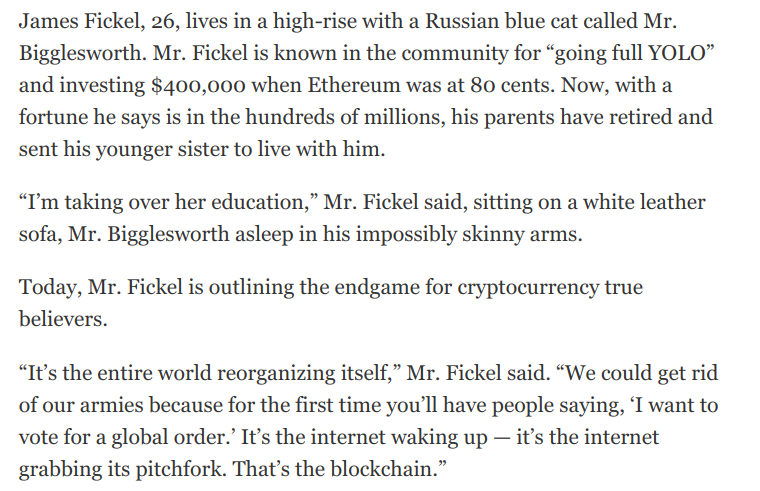“I know it when I see it,” and I’ve seen it in The Seattle Times.
Let’s start with some background.
Portfolio management is not a science, despite the profession’s diligent and extremely lucrative attempt to prove otherwise. In fact, “portfolio management as a science” has probably been the driving factor behind the biggest transfer of wealth known to mankind; the flow of money from ignorant investors to the pockets of high-fee fund managers. Can you really blame either party? For decades, we’ve seen the brightest minds of graduating classes across the country make their pilgrimage to Wall Street to reap the benefits of sitting behind very expensive desks, pretending to apply scientific rigor and a repeatable process to what is actually an art form with no undeniable “right” answers, only distinctly wrong ones. In reality, these managers have been trying to nail Jell-O to the wall and we’ve all been paying handsomely to watch them fail.
(Nowadays, our best and brightest work day and night to get you to click on Facebook ads) ¯\_(ツ)_/¯
I digress.
The science/art distinction is very important to define. The grand illusion of “Wall Street” was convincing us that there was a magic formula only a privileged few could possess. It said investing success was only attainable if you followed a very precise formula – a closely guarded scientific method, if you will – which was sending your capital to Manhattan, where they promptly toss it into a special black box, and out popped a Polaroid from the future with you and your spouse frolicking on the beach in your early 60s retirement. Pay the broker, he ran your portfolio through his laboratory, and, voila, you’re gonna be OK, you told yourself, “The money scientists have our portfolio.” You might say that you liked the guarantee on the box.
The truth is that portfolio management is much more art than science. In the art world, who’s to say one piece of art is necessarily “better” than another? It’s all in the eye of the beholder. But there is typically consensus on something being art versus it not being art, regardless of its quality. That much is easily determined.
In portfolio management, it’s a bit of the same logic, but it all comes down to prudence. A manager’s work is either prudent for his/her clients or it is not. Determining whether genuinely prudent work is of the highest quality, or is minimally prudent, is a pointless venture – it’s the equivalent of trying to rate art – because we can’t predict the future. If given a menu of ten separate managers, deemed to offer me ten different prudent portfolios, I cannot tell you which portfolio will fare best over a given future time period. I might have a hunch, but can not offer any confidence in my rankings. There’s a parallel here to the subjective “art factor.” Sometimes the dopey-looking painting (to you) sells for millions.
It’s much easier to weed out financial imprudence, just as we can simply say “that popsicle stick glued to a tennis ball is not art.”
Enter this piece from The Seattle Times.
The Times runs a “Money Makeover” series where a reader is matched up with a local advisor and is given free advice on how to fix a certain financial malady in their life. Usually it’s pretty harmless, but always well-written. The reader gets pro bono advice for offering up their story publicly while the advisor gets free advertising. Win/win!
I don’t see a win/win this week, particularly when it comes to prudent portfolio management.
In the piece we have a 50 year-old Seattle woman, soon to be divorced, with a young son, forced to re-enter the workforce with very little in the way of liquid savings ($5,000), but thankfully with a fairly healthy start on her retirement ($143,000). One can imagine she’s seeking some financial stability after going through a separation and starting back at work – two of the more stressful things a person can go through, and they’re happening concurrently.
We find out that her new income, even when combined with future ex-spousal support, will not cover her expected monthly expenses.
“Johnson’s household cash flow now runs in the red for the foreseeable future, even with 10 years of spousal support,” writes George Erb for The Times. We don’t get the exact expense numbers, but a reasonable estimate is that she has less than two months’ worth of expenses in the $5,000 cash she has on hand. This means at some point very soon our reader will have to eat into her retirement savings if nothing changes.
The advisor assigned to the case, a “Vice President for Research” at S.R. Schill & Associates, acknowledges the problem with monthly ends not meeting.
“The risk is, if she doesn’t improve her income significantly, she starts to deplete her retirement savings, and she jeopardizes her long-term future,” the advisor says. He encourages her to get her income up. Fair. No complaints from me.
But here’s where things get shaky:
The advisor prescribes a double whammy of portfolio mismanagement by shockingly recommending a very aggressive 85% allocation to equities in her retirement portfolio, then, he has the gall to tell her to expect that portfolio to return 8.5 percent per year.
Let’s tackle both parts of that recommendation:
85% Equities Portfolio
To start, the highest allocation I recommend to even the youngest, most risk tolerant clients I have, is an 80% exposure to equities. This is typical for Millennials or those with large buffers of liquid savings and confirmed, above-average risk tolerance. Keeping healthy exposure to multiple asset classes in a portfolio not only brings diversification but it lowers the volatility, or how much the account value bounces up and down. Lower volatility is easier to stomach and results in a much lower chance of an investor making an emotional mistake at the worst time, like selling out of a portfolio during a market downturn. Our reader has neither sufficient liquid savings (not even close) and an unknown risk tolerance (we, like the advisor, have only just met her) so an extra-aggressive portfolio allocation is quite puzzling. It’s wise to err on the side of caution instead of aggression in times of investor or market uncertainty, if one is trying to be a prudent manager. 85% to stocks is not cautious.
Having a high-octane portfolio packed with mostly stocks is a recipe for disaster for someone in a fragile financial, and more importantly, a potentially fragile emotional state. The last thing our reader needs is to have her “Alamo” account – the retirement assets she has built up and would use in an absolute worst-case scenario – to take a major drop when she is most in need of a backstop. Can you imagine the pain she would feel if in, say, 2019, the US hits a recession, she loses her job and her portfolio is also crippled in a bear market due to its aggressive approach? Why is this possibility on the table? Why not put the pedal to the metal at a time when she’s more prepared for the risk? Not giving thought to regret minimization is like purposely kicking the hornet’s nest, which brings us to the second subject:
8.5% Per Year Return Expectation
Setting client expectations for market returns requires extra care because when investment returns fail to deliver on a promised level, it is the goals and dreams of clients that hang in the balance. 8.5% per year is anything but conservative. “Under-promising” is the prudent way to model investment returns when building a financial plan. Planning for lower-than-average returns is a reasonable way to create a margin of safety for a client’s financial plan and it’s downright wild to quote an 8.5% expected return without a disclaimer about the overt optimism embedded in that assumption. I’ll do the math for you:
If we expect the bond portion of our reader’s proposed portfolio (the 15% not invested in stocks) to return 3% per year (generous given the factors at play in fixed income markets), then to get an 8.5% overall portfolio return she would need to have her stocks return a whopping 9.47% per year. This is at least double the low-single-digit average expected returns forecasted over the next ten years from some very capable minds in the investing world. We are currently sitting at very lofty valuations in global equity markets, locking in near-certain underwhelming returns going forward.
If you read any financial headlines, surely you’ll have read about the problems in the world of pension funds. Return estimates used by pension funds are notoriously over-optimistic, are rarely matched by actual returns, and pension fund mangers have been under pressure to rein in their expectations to more reasonable levels. Chaired by some very bright minds in the world of portfolio management, not a single pension fund listed in this release from the National Association of State Retirement Administrators (NASRA) has a return expectation as high as our VP of Research’s 8.5% per year. Not one. (The Houston Firefighters, surely investing gurus, were the lone entity to still expect 8.5% but they, too, have moved to lower it)
Pension fund managers are relentlessly lambasted for their unrealistic expectations. What does that say about 8.5% per year?
Takeaway:
- Sometimes bad advice is going to make it through the filter, and I’m perfectly fine with calling this bad advice. It won’t be the last time something questionable is posted in a newspaper.
- Skepticism is a very powerful weapon in the world of investing. Sound too good to be true? It probably is.
- Never hesitate to get a second opinion when it comes to investing advice.
- The VP of Research at S.R. Schill & Associates very well may be the brightest investing mind of our time, and will be vindicated with his uber-aggressive, mega-optimistic, non-consensus advice. He’s out on a limb and in that scenario I will happily admit it I was wrong. But I’m not betting on it.





